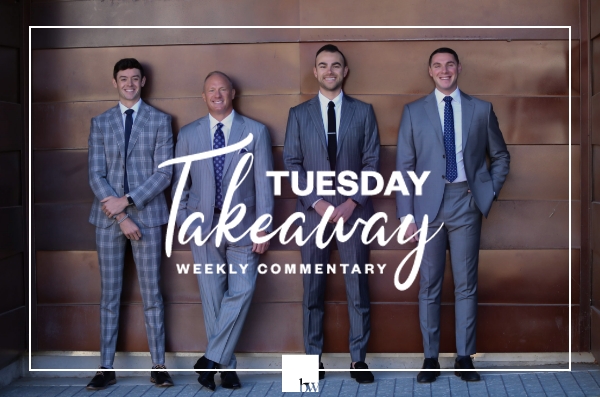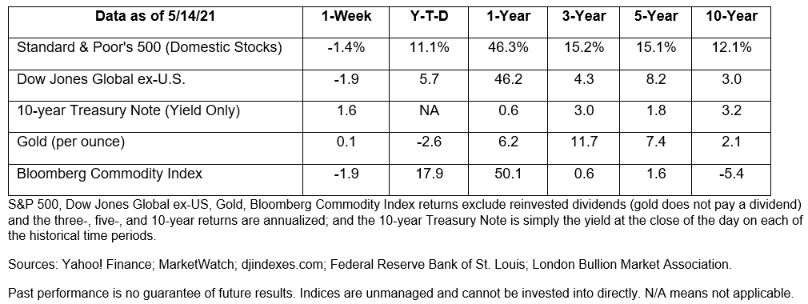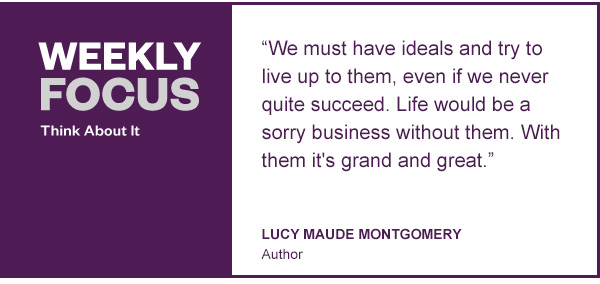
Market Insights:
January 2, 2024
Posted on January 02, 2024
Planning and Guidance, Tailored To Your Life and Goals
Tuesday Takeaway
Posted on May 17, 2021

Uncle Inflation is here. Will he overstay his welcome?
Ever since the financial crisis, central banks have pursued expansionary monetary policies to encourage reflation and avoid deflation. Well, it’s taken some time, but inflation is finally here.
Last week, major stock indices in the United States moved lower after inflation, as measured by the Consumer Price Index (CPI), was four times higher than anticipated, reported Ben Levisohn of Barron’s.
Higher inflation is the result of a supply and demand imbalance. As the pandemic has calmed in the United States, consumers have emerged eager to spend money – so eager that consumer spending is about 5.5 standard deviations above average. That’s a lot.
The problem is finding stuff to buy. The Economist explained, “…red-hot demand is increasingly met slowly or not at all…Nowhere are shortages more acute than in America, where a boom is under way. Consumer spending is growing by over 10 percent at an annual rate, as people put to work the $2trn-plus of extra savings accumulated in the past year.”
Shortages are the result of two kinks in the supply hose.
The first is the supply chain. There is a shortage “of everything from timber to semiconductors,” which are essential to building other products. In addition, shipping containers have become a scarce resource, causing the cost of shipping goods from China to the United States to triple, reported The Economist.
The second is labor. This week’s higher-than-expected inflation data mirrored last week’s lower-than-expected employment data. No one is certain why the employment numbers were lackluster, although theories abound. Regardless, there are limits on what companies can produce when they have too few employees.
The question is whether supply chains can be straightened so demand for goods and services can be met. If so, higher inflation may prove transitory as the Federal Reserve and some economists anticipate. If not, inflation may stick around. Time will tell.
(The one-year numbers in the scorecard below remain noteworthy. They reflect the strong recovery of U.S. stocks from last year’s coronavirus downturn to the present day.)


The big news last week was the announcement from the Centers for Disease Control (CDC) that fully vaccinated Americans can resume normal activities without wearing masks or social distancing, except where required by law. Suffice it to say, people are ready to return to normal.
Results from the latest Axios-Ipsos Coronavirus survey, conducted in early May, found Americans were feeling more optimistic. Among those surveyed:
If your exuberance about resuming “normal” life has been tempered by a reluctance to change the routines you’ve adopted during the pandemic, you’re not alone. Medical experts at Northwestern University explained:
“The emotional impact of this past year may linger with us for longer than we might expect. The key is not to feel forced to snap back into a routine overnight. Give yourself time and understand that your emotional journey back to freely socializing in vaccinated cohorts may look very different from those around you.” As some people say, “You do you.”

The Associated Press reported veterinarians have seen increased numbers of patients since the pandemic was declared in March 2020, including ~12.6 million U.S. households that took home new pets.
Here are other interesting tidbits effecting veterinarian practices during the past year:
You can read the AP article here.
